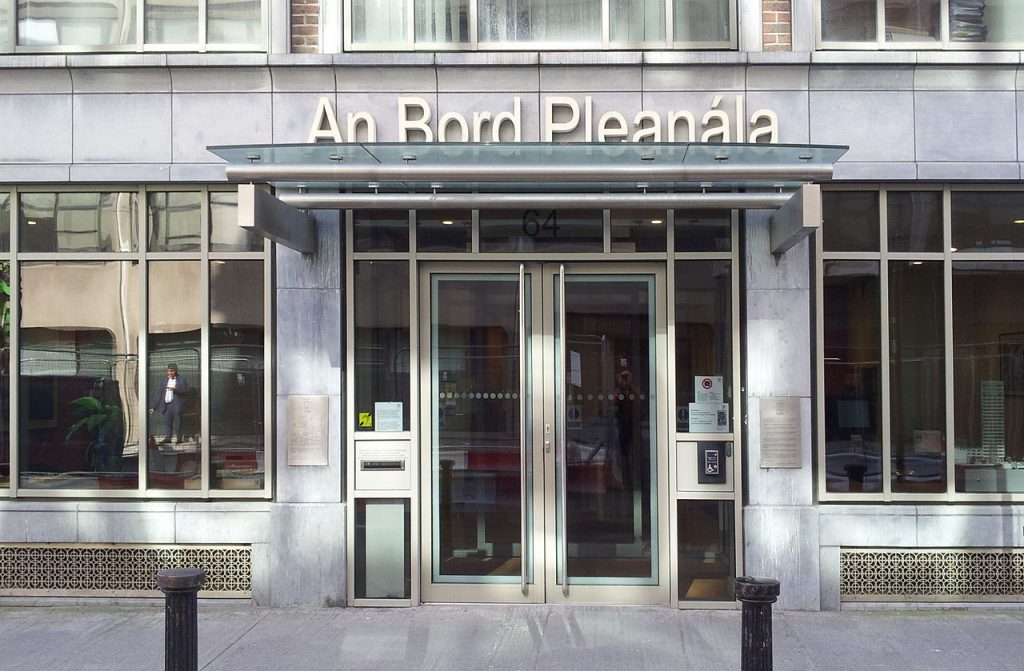July 24th, 2018
When Linda Fitzpatrick first decided to fight the construction of an incinerator in her hometown Ringaskiddy, she was a young mother to two toddlers and a newborn.
Now, her little ones are old enough to go to college, yet she is still fighting today, as the spokesperson the Cork Harbour Alliance for a Safe Environment (Chase), a citizen group against the twin incinerator project.
“My kids were small when they first announced they are going to try to build this project. I lived in Cork Harbour all my life, grown up there, and it really struck me,” she told The Green News.
“I thought if you have a big waste industry, and then something else following it, and then who knows what else next to it, you end up having a dump down in the Ringaskiddy area. I thought that the peninsula could do better.”
Google ‘Cork Harbour’ or ‘Ringaskiddy’ and you’ll get plenty of results about its residents’ unwavering 18-year-old opposition to the incinerator. They are up against Indaver, a Belgian waste management company with branches all across Europe.
The company has actively sought permission to develop a hazardous waste incinerator and a municipal waste incinerator Ringaskiddy incinerator from An Bord Pleanála (ABP) since 2001.
In May, and despite oppositions from its own inspector, the Board granted Indaver the coveted permit, a controversial decision that prompted a national outcry and condemning statements from politicians.
Chase promptly vowed to challenge the Board’s decision before the High Court. “There is palpable anger and disbelief at this decision by An Bord Pleanála,” Mary O’Leary, Chase’s Chairperson said.
It took them less than two months to gather the funds through a crowdfunding campaign to seek a judicial review of ABP’s decision, with the High Court granting permission for the group to mount a legal challenge just this morning.
Chase spokesperson Linda Fitzpatrick (left) with group Chairperson Mary O’Leary (Right) Photo: CHASE
Long, long history
In April 2001, Indaver lodged its first application with Cork County Council to construct what would have been Ireland’s first commercial waste treatment plant. Indaver hoped that the plant would be operational by 2005 when it planned to build a second facility at Cork Harbour.
The company was concurrently pursuing another licence to build a waste-to-energy plant near Duleek, Co. Meath. Both proposals prompted immediate opposition from the Green Party and locals in Cork and Meath.
That was when Linda Fitzpatrick joined Chase. “I went to a meeting down in Carrigaline in July 2001, and they were looking for volunteers so I put my name down and I’ve been involved with them since,” she says.
Meath County Council granted permission to Indaver to build the incinerator in Duleek in August 2001, with the company subsequently involved in a 10-year legal battle with the local community before construction work began in 2011.
The Ringaskiddy project, however, proved a more significant challenge, with Cork County councillors unanimously voting against the proposed facility in May 2003.
Indaver appealed the decision to ABP in June 2003, leading Chase and numerous other opposition parties to lodge counter-appeals seeking an oral hearing on the matter that was held in September and October 2003.
A senior planning inspector recommended that the application should be refused on multiple grounds, yet, the board of the planning authority overruled and granted permission for the hazardous waste incinerator.

Office of An Bord Pleanála Photo: Rwxrwxrwx
Numerous campaign groups went to the high court to seek a judicial review in March 2004, receiving the decision almost four years later that the court was refusing its application.
During this period, Indaver also applied for waste management license for a hazardous waste incinerator and a municipal waste incinerator from the Environmental Protection Agency (EPA), which was granted in late 2005 following an oral hearing.
Cork County Councillors said the EPA’s approval had zero impact on their opposing stance toward incinerators, however, Indaver were able to apply directly to ABP in late November 2008 for planning for both hazardous and municipal waste incinerators under the Strategic Infrastructure Act signed into law in 2006.
Opposition subsequently led to a second oral hearing in April 2009, with ABP open to considering permission for a hazardous waste incinerator but not a municipal waste incinerator.
The board requested further information on the likes of flooding and coastal erosion mitigation plans, which Indaver supplied in August 2010.
CHASE argued that the changes to the facilities proposed to mitigate for the above issues would mean that the facility would have to be viewed as an entirely new structure, and as such, would require a new planning application.
Indaver went ahead and did so, lodging a new application to ABP five years later in January 2016, with an oral hearing called between April and May that year.
Despite further recommendations at the oral hearing from an ABP inspector that permission should not be granted, the planning authority recently gave the green light to Indaver to build the €160 million waste-to-energy plant in Cork Harbour.

Proposed Site Location Photo: CHASE
Waste-to-Energy Issues
Indaver identifies itself as committed to providing clean energy from waste. According to its application to the Board, the Ringaskiddy plant would generate 25 megawatts of electricity from 240,000 tonnes of industrial and commercial waste each year.
The board’s newly-granted permission is subjected to 27 conditions, including a ban on treating toxic waste exported to the State, as well as a tonnage restriction on waste treatment.
In its application to the Board, the company also pledged to use modern removal and cleaning methods to prevent the reformation of dioxins in line with the EU’s Waste Incineration Directive. The company has also promised to achieve emission levels well-below the EU limits.
According to the WHO guidelines, however, areas near incinerators should not be populated. The WHO also advises against farming near incineration sites.
“The site in Ringaskiddy is unsuitable for this, it just fails on every single level, there are World Health Organisation (WHO) guidelines on where to situate incinerators, it gives ten criteria, and the site in Ringaskiddy fails nine or 10 of them,” Linda Fitzpatrick says.
Incinerators can cause air pollution by emitting dioxins, mercury, lead and a variety of other toxic substances that may invoke asthma and other respiratory ailments. Dioxin, in particular, is a controversial substance.
The chemical, most famously used in Agent Orange, a toxic defoliant utilised during the Vietnam War, can be exceedingly hazardous to human health. Research shows that exposure to high levels of dioxins can cause diseases as acute as cancer. Once in the body, dioxins mimic steroid hormones, extremely potent chemicals that naturally occur in our bodies.
In February 2016, a dark cloud of smoke coming from one of Indaver’s central waste treatment plants in Stabroek province, in the Belgian city of Antwerp, grasped the attention of people driving in its vicinity.
A storage bunker, at the plant, had reportedly exploded. It is unclear what materials were released to the environment, but Belgian firefighters advised people living nearby to keep their windows and doors shut.
Indaver claims that due to significant differences between the facilities and the type of waste being treated, incidents similar to the explosion in Belgium could not arise at the Ringaskiddy plant.

The Tánaiste Simon Coveney, TD Photo: Irish Defence Forces
Tánaiste urged to act
When the Dáil voted in favour of legislation that would grant new powers to the State to overturn planning permission for projects deemed a threat to national security, opponents to the incinerator urged the Tánaiste to revoke Indaver’s planning permission. They argued that the proposed incinerator at Ringaskiddy is jeopardising the health of officers and according to the Defence Forces might interfere with the operation of helicopters at the nearby naval base at Haulbowline.
In a statement to The Green News, Indaver said that addressed these concerns as early as last year. “The Department of Defence’s concerns about potential impact on operations at Haulbowline Naval Base were addressed comprehensively by Indaver during the Oral Hearing and in subsequent correspondence to An Bord Pleanála,” a spokesperson for the company said.
“Following assurance provided to An Bord Pleanála, in this regard, the Department of Forces wrote to the Board on July 12, 2017, outlining that if Indaver could confirm that potential risk from the plume could be contained within 150m of the slack, then it would not impact on Air Corps Operations at the Haulbowline Naval Base,” the statement reads. “Specialist air monitoring consultants subsequently provided this confirmation to the Board.”
“Modern, well-run waste-to-energy facilities pose no health risk to the public. Indaver has been successfully operating a waste-to-energy facility in Duleek, Co. Meath since 2011 and integrated well into the local community,” the company added.
Nimbyism accusations
CHASE has its own opponents accusing the group of Nimbyism. Nimby (an acronym for Not in My Backyard) is a label used to characterise locals opposing industrial developments as being overly-protective of their own turf.
Ringaskiddy is, however, already home to various industries, including water treatment and pharmaceutical businesses. “Our backyard is already full, there is so much down there in Ringaskiddy that there should not be an obligation to take the waste industry as well,” Fitzpatrick says.
“I think [the word nimby] is a slur to an extent because if you don’t stand up for your own area, no one is going to stand up for it.
“It is not fair to take away a chance for Ringaskiddy to breathe; you have to look for the reasons why someone doesn’t want something in their backyard,” Fitzpatrick continues. “If people don’t want something in their backyard, then maybe you have to look for a new solution.”
The post Cork Harbour Incinerator: Decades old battle set to rage on appeared first on Green News Ireland.










